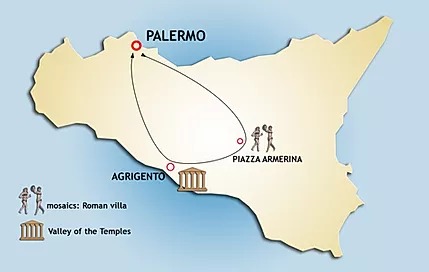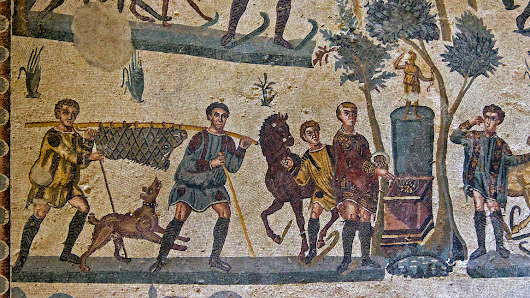Piazza Armerina and Agrigento, an amazing day tour out of Palermo
Tour Of Sicily arrange a regular day tour out of Palermo to visit both sites every Wednesday and Sundays at eur 98 per person, arranged in English, Italian and Spanish. Tour details are shown on: https://www.tourofsicily.com/tour/full-day-regular-tour-to-piazza-armerina-and-agrigento-from-palermo/Private day tours are available on request!
 What has always been amazing about the Villa del Casale, from the first excavations in the 1800’s until the final restorations, are “the superb remains of magnificent mosaics and polychrome floors of the splendid villa of the late Imperial Age” (G.V. Gentili).
What has always been amazing about the Villa del Casale, from the first excavations in the 1800’s until the final restorations, are “the superb remains of magnificent mosaics and polychrome floors of the splendid villa of the late Imperial Age” (G.V. Gentili). The very impressive mosaic complex has been the reason to include the villa in the list of Unesco World Heritage Sites making it one of the most important examples of the “Villa” architectural style, which combines on the one hand high-quality residential characteristics and on the other hand functional elements for productive activities related to its rural location.
This Villa is a monument of great historical and artistic value of the late Roman Empire.

This majestic Imperial villa, standing tall in the Province of Enna (perhaps the most “Roman” of places on the Island), is a magnificent rural abode, fascinating, above all, for its captivating mosaics, considered the most beautiful and best-preserved of their kind.
Roman Villa (trans. Roman Country Villa) in Piazza Armerina is considered to be one of the most important exemplars of an official governmental residence, attributed to the elaboration and exceptional beauty of its architectonic and decorative elements.
Archaeologists undertook an important excavation project in the mid-18th Century, bringing to light 37,674 sq ft of mosaic flooring – figurative and geometric – along with wall mosaics, columns, statues, capitals and coins. The theme of the mosaics?
They are essentially, in part, paeans to the homeowner himself, and they are done, one might add, with a certain profundity and eloquence.
Moreover, much of the house exhibits a definite influence from North African art styles, leading diggers and academics to believe that some of the construction workers from the African Continent.
In the mosaics, the viewer can detect varying styles and narrative cycles: one is dedicated to mythology and to Homeric poems, while another refers to nature and scenes from the Roman aristocracy’s quotidian life.
Four distinct zones have been identified from the villa’s remains: the monumental entrance with courtyard in horseshoe form; the villa’s center, built around another courtyard garden; a large room with three apses (trichora), preceded by an oval peristyle lined by several large niches; and the thermal baths complex. Years-long restoration works centered around the mosaics and murals concluded only recently, in December 2012.
Our day tour continue onto the amazing Agrigento to visit the Valley of the Temples.

Then, the rediscovery of Akragas began towards the end of the eighteenth century, when the first European travellers reached Sicily, discovering an unexpected and immense artistic, archaeological heritage.
The Valley of the Temples is certainly the most important testimony of the ancient, classical culture of Sicily. It brings together the temples of gods goddesses as well as the area of the necropolis and sanctuaries outside the walls.

